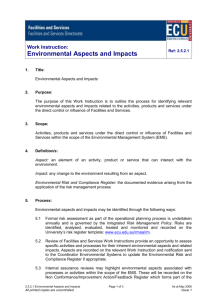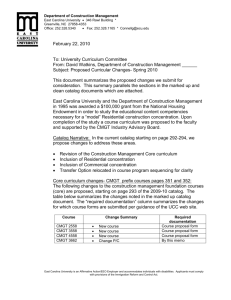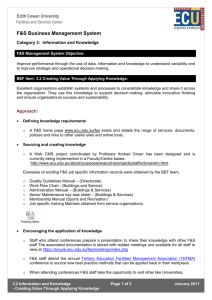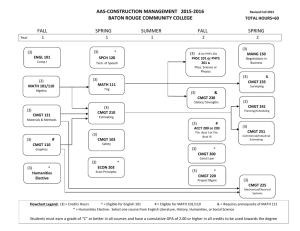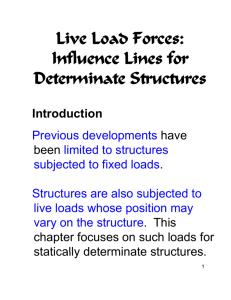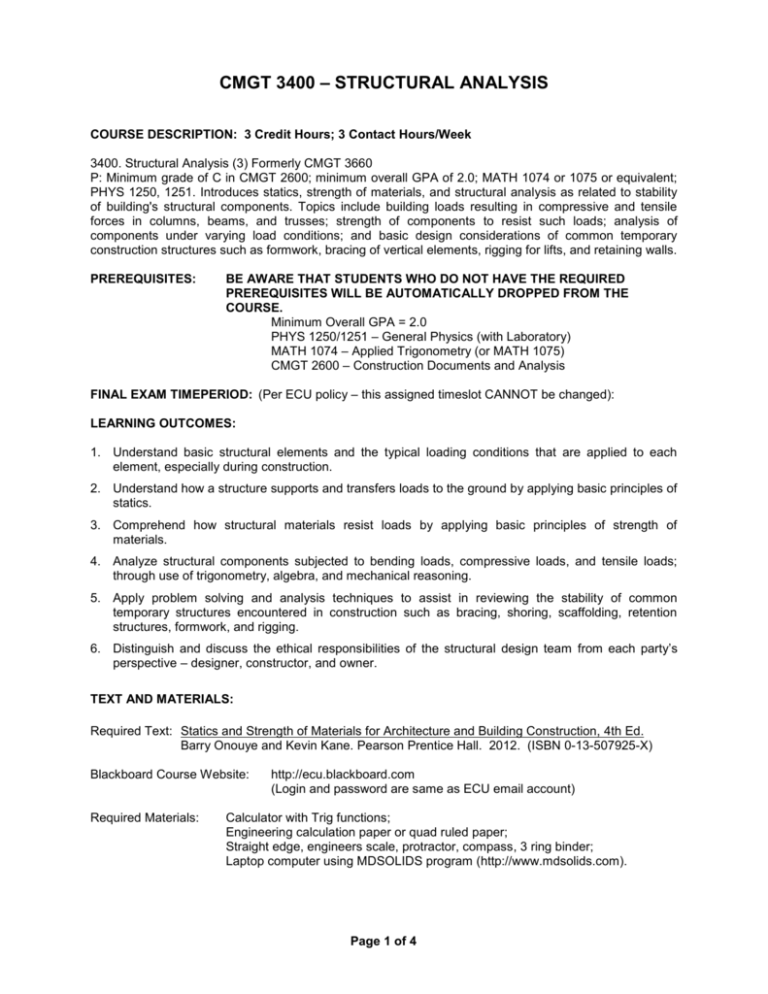
CMGT 3400 – STRUCTURAL ANALYSIS
COURSE DESCRIPTION: 3 Credit Hours; 3 Contact Hours/Week
3400. Structural Analysis (3) Formerly CMGT 3660
P: Minimum grade of C in CMGT 2600; minimum overall GPA of 2.0; MATH 1074 or 1075 or equivalent;
PHYS 1250, 1251. Introduces statics, strength of materials, and structural analysis as related to stability
of building's structural components. Topics include building loads resulting in compressive and tensile
forces in columns, beams, and trusses; strength of components to resist such loads; analysis of
components under varying load conditions; and basic design considerations of common temporary
construction structures such as formwork, bracing of vertical elements, rigging for lifts, and retaining walls.
PREREQUISITES:
BE AWARE THAT STUDENTS WHO DO NOT HAVE THE REQUIRED
PREREQUISITES WILL BE AUTOMATICALLY DROPPED FROM THE
COURSE.
Minimum Overall GPA = 2.0
PHYS 1250/1251 – General Physics (with Laboratory)
MATH 1074 – Applied Trigonometry (or MATH 1075)
CMGT 2600 – Construction Documents and Analysis
FINAL EXAM TIMEPERIOD: (Per ECU policy – this assigned timeslot CANNOT be changed):
LEARNING OUTCOMES:
1. Understand basic structural elements and the typical loading conditions that are applied to each
element, especially during construction.
2. Understand how a structure supports and transfers loads to the ground by applying basic principles of
statics.
3. Comprehend how structural materials resist loads by applying basic principles of strength of
materials.
4. Analyze structural components subjected to bending loads, compressive loads, and tensile loads;
through use of trigonometry, algebra, and mechanical reasoning.
5. Apply problem solving and analysis techniques to assist in reviewing the stability of common
temporary structures encountered in construction such as bracing, shoring, scaffolding, retention
structures, formwork, and rigging.
6. Distinguish and discuss the ethical responsibilities of the structural design team from each party’s
perspective – designer, constructor, and owner.
TEXT AND MATERIALS:
Required Text: Statics and Strength of Materials for Architecture and Building Construction, 4th Ed.
Barry Onouye and Kevin Kane. Pearson Prentice Hall. 2012. (ISBN 0-13-507925-X)
Blackboard Course Website:
Required Materials:
http://ecu.blackboard.com
(Login and password are same as ECU email account)
Calculator with Trig functions;
Engineering calculation paper or quad ruled paper;
Straight edge, engineers scale, protractor, compass, 3 ring binder;
Laptop computer using MDSOLIDS program (http://www.mdsolids.com).
Page 1 of 4
COURSE TOPICS
Introduction, Class Policies, Syllabus Review
Math Review PRETEST
Definition of Statics, Strength of Materials, Structure Analysis
o function of structures; review of loading; loadings as forces applied to rigid bodies
Force systems; adding 2 or more concurrent forces (resultant)
o graphical addition; rectangular components of forces
Vector addition
o mathematically by Resultant of concurrent force systems: rectangular components
Finding resultant by summing components (Mathematical Vector Addition)
Review of rectangular components
o Nonconcurrent Force Systems: Def. of Moments, Moment Arm;
Free Body Diagrams
o Nonconcurrent force systems (rigid bodies), Support conditions, Solving for reactions
Equilibrium of rigid bodies
o Solving for reactions. (ALGEBRA)
Review of equilibrium, FBD's
o Using to solve for reactions of rigid bodies
Introduction to distributed loading.
Modeling distributed loads on FBD
o Solving for reactions of simply supported beams (rigid body equilibrium).
Solving for reactions of simply supported beams (Rigid Body Equilibrium).
Using MDSOLIDS as tool for finding reactions at supports
Intro to Truss analysis
o Internal forces vs. applied external forces
Truss analysis by method of joints to find internal forces
o Using MDSOLIDS as tool for truss analysis.
Truss analysis
o Recognizing short-cuts in truss analysis: Symmetry in loading and configuration.
Recognizing short-cuts in truss analysis
o 0-force members in trusses.
Distributed Loading and Truss
Intro to Strength of Materials; Stress Defined; Normal Stress
Stress Defined
o Normal Stress; Shear Stress, and Bearing Stress; Stress example problems.
Deformation and strain
o Elasticity; Relationship between stress and strain; Material properties; working stress,
modulus of elasticity
Cross Section Properties
o Centroids; Moment inertia
Shear & moment diagrams - graphically by MDSOLIDS
Bending & Shear Stresses in beams
o Section Modulus
Using section modulus to select adequate members
Deflection in beams
o deflection equations
ATTENDANCE POLICY FOR ALL CONSTRUCTION MANAGEMENT COURSES:
Active student participation is sought in all construction management courses. To support this objective,
attendance is paramount for academic success and reinforces the value of student-faculty and studentstudent interactions. Therefore, students are required to attend AT LEAST 75% of all course meetings in
order to earn credit for any construction management course, regardless of any other grading criteria.
Page 2 of 4
Attendance and punctuality is required in all Construction Management courses but no grade is given for
attendance or punctuality. Instead, absences and tardiness have a significant negative impact on your
grade. Course work missed by absence or tardiness will be recorded as a zero.
Student attendance and punctuality will be recorded for all scheduled course meetings including the first
and last week of classes. In all cases, the student should notify his or her instructor by email as soon as
they realize they will be absent.
CMGT Departmental attendance policy includes absence and tardiness. A student’s final course grade,
at a minimum, will be reduced by the following percentage points (based on 100% scale) for each
occurrence.
50 minute class - 2% deduction
75 minute class - 3% deduction
120 minute laboratory - 2% deduction
180 minute laboratory - 3% deduction
COURSE GRADING: FINAL course grade will be posted to BANNER (Accessible through Onestop
portal at www.onestop.ecu.edu). Grading during the semester will be posted to the secured Blackboard
course website.
TENTATIVELY, the breakdown of the FINAL COURSE GRADE will be:
Tests (5)
Homework Quizzes
TOTAL
GRADING SCALE: (No rounding)
A
90.00 - 100.0
B
80.00 - 89.99
C
70.00 - 79.99
D
60.00 - 69.99
F
59.99 or below
75%
25%
100%
TESTS: Five tests will be given throughout the semester with the last test given during the assigned final
exam time slot. Missed tests CANNOT be made up without arrangements BEFORE the test date.
HOMEWORK: Assignments are intended to provide the student with an opportunity to apply techniques
in the subject matter and generate a reference manual relating to each topic. In order to provide a useful
reference, format and organization of the assignments will be critical. It is suggested that students
maintain a HOMEWORK NOTEBOOK organized by topic, including all assigned problems completed
using the specified format. Doing homework regularly and organizing it efficiently has been linked to
higher grades in the course.
Homework mastery will be evidenced by performance on HOMEWORK QUIZZES (On-line and in-class).
Missed quizzes cannot be made-up. On-line quizzes will be activated during a minimum 48 hour
window and accessed through Blackboard. Unannounced in-class quizzes should also be anticipated.
COURSE CALENDAR: Refer to the posted COURSE MEETING SCHEDULE for a listing of topics and
associated references to be discussed at each class meeting. As the schedule is revised, the most
current version will be posted to Blackboard.
ACADEMIC INTEGRITY:
Syllabus)
(New ECU Academic Integrity Policy effective Fall 2011 is in Bb under
Academic integrity is a cornerstone value of the intellectual community at East Carolina University.
Academic integrity ensures that students derive optimal benefit from their educational experience and
their pursuit of knowledge. Violating the principle of academic integrity damages the reputation of the
university and undermines its educational mission. Without the assurance of integrity in academic work,
Page 3 of 4
including research, degrees from the university lose value, and the world beyond campus (graduate
schools, employers, colleagues, neighbors, etc.) learns that it cannot trust credits or a diploma earned at
ECU. For these reasons, academic integrity is required of every ECU student.
ACADEMIC INTEGRITY VIOLATIONS:
Academically violating the Honor Code consists of the following:
1. Cheating. Unauthorized aid or assistance or the giving or receiving of unfair advantage on any
form of academic work.
2. Plagiarism. Copying the language, structure, ideas, and/or thoughts of another and adopting
same as one’s own original work.
3. Falsification. Statement of any untruth, either spoken or written, regarding any circumstances
relative to academic work.
4. Attempts. Attempting any act that if completed would constitute an academic integrity violation as
defined herein.
STUDENT OBSERVATION OF SUSPECTED VIOLATION:
A student or group of students knowing of circumstances in which an academic violation of the Honor
Code may have occurred or is likely to occur is encouraged to bring this knowledge to the attention of the
responsible faculty member, or to the dean or department chairperson, or to the attention of a member of
the University Academic Integrity Board.
CODE OF PROFESSIONAL ETHICS:
Class activities and interactions are to be governed by the American Institute of Constructors’ Code of
Ethics. The AIC Code can be found at http://www.aicnet.org/about/code_of_ethics.asp. All participants
are expected to adhere to these guidelines in dealings with classmates, your instructor, and class visitors.
Smoking is prohibited in all ECU classrooms.
Cell phones must be turned OFF or SILENCED during class meetings.
Page 4 of 4




